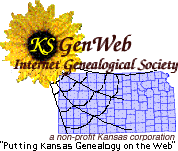

| St. Patrick's Church | The Rise and Fall of Sumner | Old Sumner |
St. Patrick's Catholic Parish
Mt. Pleasant, Atchison County, Kansas
The following is taken from a clipping found at the Kansas Historical Library, Topeka, Kansas, in a book of clippings about Catholic Churches in Kansas. This one does not give the name of the newspaper where it was published, but the date is Spring, 1947.
40 Families; mostly Irish, constituted St. Patrick's parish of Mt. Pleasant, South Atchison, when the rock church was built in 1866. The church is still in use, and the pastor, Father Ambrose Keating, O.S.B., lives in the rectory. The church replaced an old log structure (20 x 30 feet) which served for several years as both a church and school.
In the spring of 1857 Benedictine monks were sent West by their American founder, Abbot Boniface Wimmer, O.S. B., to establish a priority in the Eastern part of Kansas. They settled in the hills of Doniphan and from there founded and attended the missions in Doniphan, Atchison, Brown, Nemaha and Jefferson counties. Among the very first parishes founded by these pioneer Benedictines was St. Patrick's, established by Father Augustine Wirth, O.S. B., near Mt. Pleasant in Walnut township, about seven miles directly south of Atchison. This district was known as Mt. Pleasant because its post office was in the little village two miles to the southwest, which had been founded by the Mormons in the early '40's. In 1858 the Catholic population of the settlement known as St. Patrick's consisted of some 30 Irish families, for the most part emigrants from Philadelphia and Baltimore.
Father Augustine's first visit to St. Patrick's was a memorable one. He came all the way from Doniphan, a distance of about 14 miles, over the prairies and through dense timber on foot. The few Catholic settlers decided that he must not walk back or again venture the distance on foot. After the services they quietly collected money to pay for a horse, a saddle, and a bridle. They then purchased the outfit from a man in the neighborhood, brought it to Father Augustine, and said: "Father, this pony, saddle, and bridle are yours; accept them as a small token of our appreciation for your sacrifice in our behalf. Hereafter you must ride when you come to us for divine service."
Father Augustine visited the Mt. Pleasant district about once a month in the fall of 1857 and very often in the two succeeding years. Occasionally Father Edmund Langefelder, O.S.B., took his place. Mass was said in the humble log cabins of Catholic settlers, usually in the homes of John Knowles, Owen Grady (now the J.J. Weinmann place), Ned Cotter (now the M.F. Owens place), Bernard Lee, James McArdle, and others.
The first marriage on records was that of James Barry and Catherine Hennessy on May 9, 1858, in the home of Edward Cotter. The first Baptism on records was that of Mary Honorah Clare on Sept 28, 1858. That same year the following were also baptized: John Durkin, Elizabeth Anna Clare, Patrick Dorrigan, Margaret Kinney, and Martha Sabina Cotter.
'Balloon Church' Blows Away
Late in the fall of 1859 Father Augustine suggested the erection of a small church, and the proposal met with the approval of his humble flock. Within a few months the congregation erected out of native lumber the long and narrow building that later came to be known as the "Balloon church." A windstorm that destroyed Sumner, Kansas, in June 1860, also razed St. Patrick's first church. People said: "Our church went up like a balloon." Mass was said in private homes again until the summer of 1861, when a log church was built on the old church site.
The log church was 20 by 20 feet. In the winter of 1860-1861 men of the parish had cut the timbers from the best trees on their places and hauled them to the church site. Early in the spring they came with axe and saw to prepare the logs for the building; others who knew the art of log construction built the church. The blessing of the new church was a very simple ceremony. Father Augustine, vested in alb and stole, sprinkled the walls inside and out with holy water and then invited the people to come in for Mass. This building served the faithful as church and school until the present rock church was erected in 1866. The old church then became a district school.
The early settlers who contributed labor, material, and money to the erection of the first two churches were Owen Grady, John Cotter, Dan Dorrigan, William Hassit, Edward Cotter, Thomas Kinney, John Glancy, Bernard Lee, Big and Little Michael Hegarty, Daniel Hanley, Patrick Hegarty, Patrick Manix, Patrick Murphy, Pat Quirk, William Meany, John Knowles, Jeremiah Flynn, John Hannahan, James McArdle, Peter Limney, Nicholas Greiner, John Weber, Patrick Dirkin, James McCarroll, James Barry, and Peter Penning. The last two persons were residing in Sumner. There were 40 families, mostly Irish, in the parish in 1864.
In 1859 the Benedictines moved their headquarters to Atchison. The community had been reinforced with young priests from the mother-house in Pennsylvania, and St. Patrick's was attended at different times by the following priests until the year 1865; Fathers Edmund Langenfelder, Casimir Seitz, Phillip Vogt, Emmanuel Hartig, Tomas Bartl, and Severin Gross. Two secular priests, Fathers Koening and Koch, who were staying in Atchison awaiting orders from their Bishop, also attended St. Patrick's on several occasions.
In the early fall of 1865 Father Timothy Luber, O.S.B., was appointed first regular pastor of St. Patrick's church. He soon saw that the log church was too small. The membership of the parish had grown so that there was hardly seating room for the women and children and men had to remain outside and hear Mass through the window.
In a meeting of the men of the parish it was decided to build a permanent rock church. Good building stone was near at hand, and there were excellent stonemasons among the members of the parish. There was some division of opinion as to the location of the church. Some wished to build on the Jacob Wienmann place, and others favored the old McNally place. Finally Father Augustine, superior of the Atchison priory, came out, stepped off the location for the corners of the church, and ordered excavation begun on the foundation, 28 by 80 feet.
The foundation was finished before winter, and the walls were begun in the spring. The stonework was let to Edward McCourt for his bid of $3.25 per perch in the wall. The entire building contains about 950 perches. By the fall of 1855 the walls were completed. Thomas Wallace from Atchison constructed the roof of native lumber. Although the stone walls were two feet thick and only 20 feet high, no one would venture to go up to fasten the rafters. Finally three prominent Irishmen--Patrick Durkin, Patrick Quirk, and a helper--having taken out life insurance from Father Timothy, climbed up and fastened the rafters while Contractor Wallace remained on "terra firma" and sighted the green timbers. The town was covered temporarily with boards and left unfinished until its completion in 1871 by Jack Wagner and Peter Weins. The circular window above the altar, the only one with art glass, was donated by the family of Michael Glancy.
Though the new church was under roof, it was without any interior finishings. Yet it was necessary to use it for divine services because the old log church could not contain the congregation. Consequently the church had to be dedicated. Because Bishop Miege was unable to come for the blessing, Father Augustine, assisted by Father Timothy and another priest from Atchison, blessed the new church on Dec. 8, 1866. The occasion was a grand event, and old settlers speak of it with considerable enthusiasm. Father Augustine preached the sermon and Father Timothy took up a big collection. Some three years later, Bishop Miege solemnly dedicated the church and at the same time blessed the cemetery.
St. Patrick's church is 28 by 80 feet inside and 25 feet form floor to center of ceiling. It has a spire measuring 45 feet from the ground; ten large Gothic windows, one circular window over the high altar, a gallery extending 18 feet, a vestibule six by eight feet, and a basement 20 by 20 feet. Through 45 persons subscribed $2,308, there was debt of some $3,000 on the new church. Money had to be borrowed at 10 and 12 per cent interest.
In these pioneer days St. Patrick's congregation had no resident pastor, and services were held only on certain Sundays. It was only in the early '80's that the people began to have Mass on all Sundays and holy days. Before 1869 no parish records were kept at St. Patrick's. Baptisms, marriages, funerals, and confirmations ere entered in the books of St. Benedict's parish, Atchison. These early records, however, are now entered in the registers of St. Patrick's parish.
The property belonging to St. Patrick's consist of 20 acres. The first seven acres were donated to Father Augustine by Bernard Lee. The deed was made in Bishop Miege's name and filed away in the archives of the Leavenworth Chancery. Jeremiah Flynn donated three acres for the cemetery. Later Phillip Knowles gave five acres, and about the same time Edward Cotter donated five acres.
The original burying ground for the deceased pioneers of St. Patrick's and vicinity was the southeast corner of what is at present the district school lot. Bryant McCourt, John Hannahan, and others from Atchison were interred there. This was the Catholic cemetery for Atchison county before St. Benedict's cemetery north of Atchison was laid out. In the early '60's Father Augustine received a donation on one acre from Jeremiah Flynn ("Jerrie"s Acre")-a narrow strip of land extending from the northeast corner of his farm several rods farther south than the present cemetery. Some years later two more acres were donated by the same benefactor, and Father Timothy, assisted by Jeremaiah Flynn and W. S. Purcell, surveyed and staked off the present cemetery. The remains of most of the deceased buried in the school lot were transferred to the new cemetery soon after.
In the summer of 1868 Father Timothy announced that a big debt was hanging over the congregation at a heavy rate of interest and that he must hold a fair to raise the interest. The proposition wad taken up by the people with lively enthusiasm. When the date of the fair arrived the men pitched a large tent, erected seats, bowling allies, shooting galleries, etc., and the women came with baskets filled all manner of eatables. For miles around the people came to have a grand old time. That fair, the first in the parish's history, netted the surprising sum of $800.
In the fall of 1875, St. Patrick's had it first mission. The missionaries were two Benedictines from Atchison, Fathers Peter Kassens and Timothy Luber. The services lasted Sunday to Sunday, and at the end the entire congregation had received the sacraments and had been enrolled in the Scapular Society of Our Lady of Mt. Carmel. The people were undecided with of the fathers was the better preacher. "Father Timothy," they said, drove home his points, but Father Peter was the more interesting."
![]()
Return to Atchison County Page
![]()
 Rebecca
Maloney / maloneys7193@gmail.com
Rebecca
Maloney / maloneys7193@gmail.com
 |
 |